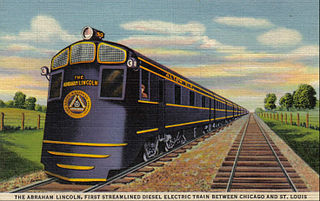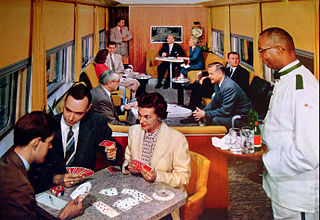
La Paz, officially known as Nuestra Señora de La Paz, also named Chuqi Yapu (Chuquiago) in Aymara, is the seat of government and the de facto national capital of the Plurinational State of Bolivia. With an estimated 789,541 residents as of 2015, La Paz is the third-most populous city in Bolivia. Its metropolitan area, which is formed by La Paz, El Alto and Viacha, makes up the most populous urban area in Bolivia, with a population of 2.3 million. It is also the capital of the La Paz Department.

La Paz is a town in North Township, Marshall County, Indiana, United States. The population was 561 at the 2010 census.

The Broadway Limited was a passenger train operated by the Pennsylvania Railroad (PRR) between New York City and Chicago. It operated from 1912 to 1995. It was the Pennsylvania's premier train, competing directly with the New York Central Railroad's 20th Century Limited. The Broadway Limited continued operating after the formation of Penn Central (PC) in February 1968, one of the few long-distance trains to do so. PC conveyed the train to Amtrak in 1971, who operated it until 1995. The train's name referred not to Broadway in Manhattan, but rather to the "broad way" of PRR's four-track right-of-way along the majority of its route.

The 20th Century Limited was an express passenger train on the New York Central Railroad (NYC) from 1902 to 1967. The train traveled between Grand Central Terminal (GCT) in New York City and LaSalle Street Station in Chicago, Illinois, along the railroad's "Water Level Route".

The Richmond, Fredericksburg, and Potomac Railroad was a railroad connecting Richmond, Virginia, to Washington, D.C. The track is now the RF&P Subdivision of the CSX Transportation system; the original corporation is no longer a railroad company.

The B&O Railroad Museum is a museum exhibiting historic railroad equipment in Baltimore, Maryland, originally named the Baltimore & Ohio Transportation Museum when it opened on July 4, 1953. It has been called one of the most significant collections of railroad treasures in the world and has the largest collection of 19th-century locomotives in the U.S. The museum is located in the Baltimore and Ohio Railroad's old Mount Clare Station and adjacent roundhouse, part of the B&O's sprawling Mount Clare Shops site begun in 1829, the oldest railroad manufacturing complex in the United States.

The Philadelphia, Wilmington and Baltimore Railroad (PW&B) was an American railroad company itself a result of merger of four small lines dating from the earliest days of American railroading in the late 1820s and early 1830s, that operated from 1836, until being bought by a larger regional line in 1881, with a merger into a longer Northeast Corridor railway in 1902. It built the first rail line south from Philadelphia into The South.

The Capitol Limited was an American passenger train run by the Baltimore and Ohio Railroad, originally between New York City and Grand Central Station in Chicago, Illinois, via Union Station, Washington, D.C., and Pittsburgh. For almost 48 years, it was the B&O's flagship passenger train, noted for personalized service and innovation. At the time of its discontinuation on May 1, 1971, when Amtrak took over most rail passenger service in the U.S., the Capitol Limited operated between Washington and Chicago.

The Cincinnatian was a named passenger train operated by the Baltimore and Ohio Railroad (B&O). The B&O inaugurated service on January 19, 1947, with service between Baltimore, Maryland and Cincinnati, Ohio, carrying the number 75 westbound and 76 eastbound, essentially a truncated route of the National Limited which operated between Jersey City, New Jersey and St. Louis.

The National Limited was the premier train of the Baltimore and Ohio Railroad (B&O) on its route between New York City and St. Louis, Missouri, with major station stops in Washington, D.C., and Cincinnati, Ohio. It operated from 1925 to 1971. For much of its life it offered exclusive all-Pullman service, and it was the first long-distance train to be entirely air-conditioned. The National Limited was one of many trains discontinued when Amtrak began operations in 1971. Amtrak revived the name for another New York–St. Louis service which did not use the B&O route.

The Abraham Lincoln was a named passenger train operated by the Baltimore and Ohio Railroad from 1935 into the 1960s. The "Abe Lincoln" ran between Chicago and St. Louis on the B&O's subsidiary Alton Railroad. The train later passed to the Gulf, Mobile and Ohio Railroad, and then finally to Amtrak, which retained the name until 1978. Service between Chicago and St. Louis is now known by the umbrella term "Lincoln Service". This train was the first streamlined passenger service to travel the 284 miles between Chicago and St. Louis, with Joliet, Bloomington-Normal, Springfield and Alton in between. Passengers can get a glimpse of the Mississippi River between Alton and St. Louis.
Peter Wayner is a writer known for his books on technology and his writing in mainstream publications including The New York Times, InfoWorld, and Wired magazine. His work on mimic functions, a camouflaging technique for encoding data so it takes on the statistical characteristics of other information, is an example of steganography. This work formed the seed for his book, Disappearing Cryptography, one of the earliest to explore how information can be camouflaged through algorithms to appear to be another form. His book, Policing Online Games, was cited by Craig Steven Wright as one of the earliest explanations and inspirations for decentralized currency systems like Bitcoin.

The Baltimore Terminal Subdivision is a railroad line owned and operated by CSX Transportation in the U.S. state of Maryland. The line runs from Baltimore to Halethorpe along the original Baltimore and Ohio Railroad (B&O) line, one of the oldest rail lines in the United States and the first passenger railroad line. At its east (north) end, it connects with the Philadelphia Subdivision; its west (south) end has a junction with the Capital Subdivision and the Old Main Line Subdivision.

The Land O'Corn was a streamlined passenger train operated by the Illinois Central Railroad between Chicago, Illinois, and Waterloo, Iowa, from 1941 until 1967. Its inception was due in no small part to John W. Rath of Ackley, IA and part owner of the Rath Packing Co. of Waterloo, Iowa as well as a member of the Illinois Central's board of directors. It featured a wide range of equipment over its existence, including self-propelled Motorailers and steam locomotives, before finally adopting conventional diesel locomotives and lightweight cars. The Illinois Central discontinued the Land O'Corn in 1967; Amtrak later operated the Black Hawk over part of its route.

The Chessie was a proposed streamlined passenger train developed by the Chesapeake and Ohio Railway (C&O) in the late 1940s. The brainchild of C&O executive Robert R. Young, the Chessie would have operated on a daylight schedule between Washington, D.C., and Cincinnati, Ohio. The train's luxury lightweight equipment was built new by the Budd Company. A revolutionary new steam turbine locomotive would have provided power, including speeds up to 100 miles per hour (160 km/h). Although the equipment was delivered, a worsening financial outlook led to the cancellation of the train before it operated in revenue service.

The Mainstreeter was a passenger train on the Northern Pacific Railway between Chicago, Illinois, and the Pacific Northwest from 1952 to 1971. When the North Coast Limited got a faster schedule in November 1952 the Mainstreeter was introduced, running roughly on the North Coast's old schedule but via Helena. Unlike the North Coast the Mainstreeter was not a true streamliner as it carried both new lightweight and traditional heavyweight coaches. It replaced another train, the Alaskan. The name referred to the Northern Pacific's slogan, "Main Street of the Northwest." While Amtrak did not retain the train as part of its initial route structure, it created a new train named the North Coast Hiawatha several months afterwards. That train ran until 1979.

The Strata-Domes were a fleet of five streamlined dome cars operated by the Baltimore and Ohio Railroad ("B&O"). The term referred both to a pair of dome cars constructed by Pullman-Standard and three Budd Company domes the B&O acquired from the Chesapeake and Ohio Railway ("C&O"). They were the first dome cars operated in the Eastern United States, following on the success of the Chicago, Burlington and Quincy Railroad's "Vista-Domes" in the west. The cars entered service in 1949 and were all out of regular service by 1981. Several have been preserved.

The View series was a fleet of six sleeper-observation lounges built by Pullman-Standard for use on the Pennsylvania Railroad's passenger trains. Pullman built four in 1938 and another two in 1949, after World War II. Their most prominent assignment was on the Broadway Limited, the Pennsylvania's flagship New York–Chicago train, but they were also assigned to the General and the Liberty Limited. Several of the cars have been preserved.



















